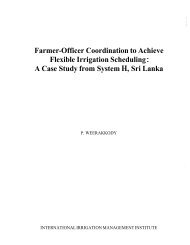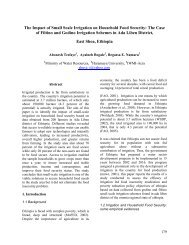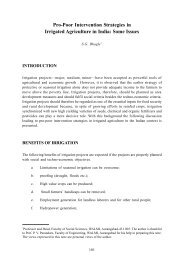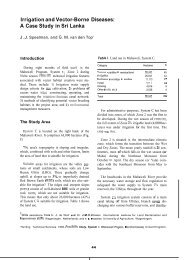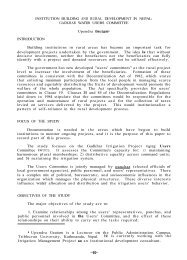WATER POVERTY IN THE NORTHEASTERN HILL REGION (INDIA)
WATER POVERTY IN THE NORTHEASTERN HILL REGION (INDIA)
WATER POVERTY IN THE NORTHEASTERN HILL REGION (INDIA)
You also want an ePaper? Increase the reach of your titles
YUMPU automatically turns print PDFs into web optimized ePapers that Google loves.
<strong>WATER</strong> <strong>POVERTY</strong> <strong>IN</strong> <strong>THE</strong> NOR<strong>THE</strong>ASTERN <strong>HILL</strong> <strong>REGION</strong> (<strong>IN</strong>DIA): POTENTIAL ALLEVIATION THROUGH MULTIPLE-USE <strong>WATER</strong> SYSTEMSMethodology for Constructing Water Poverty Map andWater Poverty Index43Annexure-IFor the construction of the Water Poverty Map, a Water Poverty Index has been constructed which takesinto consideration multiple indicators for estimating water poverty.Mathematical structure of the WPIThe WPI is calculated using a composite index approach similar to the one used for Human DevelopmentIndex (HDI). Various elements measured in different units are aggregated together, and the five keycomponents are combined using the general expression:WPI =∑∑Where, WPI= Water Poverty Index value for a particular location, Xi = component (Resource, Access,Use, Capacity or Environment) and, w = weightThe application of the framework provided by the WPI enables a more consistent approach to decisionmaking, and decisions can be both audited and defended. Depending on the purpose of its use, theWPI can be applied at a range of different scales. To determine the degree of need for water provision,it can be applied at the community level, and at the intermediate and national scales (Sullivan 2005).Here, for the purpose of the current study, the WPI is applied at the household level.Consistent representation of components at each scale facilitates meaningful comparisons, and variablescan be determined by stakeholders according to local needs, WPI structure for that location, and wi isthe weight applied to that component. Each component is made up of a number of sub-components,and these are first combined using the same technique in order to obtain the components. For thecomponents listed above, the equation can be re-written:WPI = wrR + waA + wcC + wuU + weEwhere w r,w a,w c,w uand w eare the relative weighing factors for each key components.Calculating the WPI in this way provides the weighted average of the five components Resources (R),Access (A), Capacity (C), Use (U), and Environment (E). Each of the components is first standardised sothat it falls in the range 0 to 1; thus the resulting WPI value is also between 0 and 1. A low score on theWPI indicates a more extreme case of water poverty. The weight given to the elements w i, represents therelative importance given to each of the them.Calculating indicesScores for each index and sub-index are calculated by the formula:xi − x minxmax−xmin ;where x i, x maxand x minare the original values for household i, for the highest value household, and for thelowest value household, respectively. The index for any one indicator lies between 0 and 100. The aim isto get index values in the range 0 to 100 for each quantity being considered, where 0 is worst, and 100is the best. When these are combined to make a composite index, then each component is on the samebasis (Sullivan 2005).Ni=1Ni=1wiXiwi



